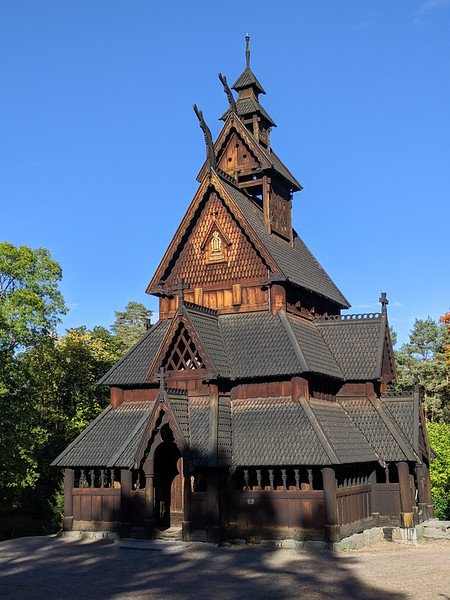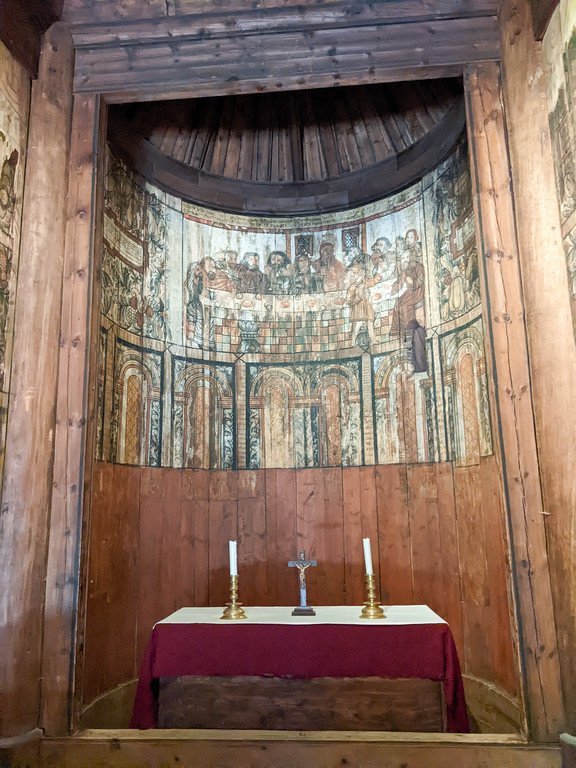Visual analysis theme for 2024
I am sharing my university essay on the Medieval Gol Stave Church now located in Oslo, Norway. There are some very interesting comparisons with the church and nature and Nordic mythology. Enjoy!
In the 1880s King Oscar II of Sweden and Norway saved the Gol Stave Church from destruction. He financed the relocation and restoration of the Gol Stave Church from Gol to Oslo and the Norwegian Museum of Cultural History. The church has been dated to the 12th century, right in the middle of the architectural boom of stave churches in Norway. Carolyne Lindholm claims that seven or eight hundred of these churches were built from the eleventh to the thirteenth centuries and now only about twenty remain. Bjorn Braathen argues, “Stave churches were once common in northern Europe, and in Norway alone, between 1000-2000 were built. Today, 28 historical stave churches remain standing in Norway.” Whether the number is in the hundreds or thousands an extensive number of stave churches have disappeared. After surviving over 600 years of weather, wars, and the Reformation, the striking medieval stave church in Gol was to be demolished when the city planned to build a modern church in its stead. During the renovation, the dilapidated exterior was considerably renovated and many details were copied from the famous Borgund Stave Church.
 Figure 1. Gol Stave Church, Oslo, Norway. Photo S. Jarvie
Figure 1. Gol Stave Church, Oslo, Norway. Photo S. Jarvie
The Gol Stave Church is an architectural marvel entirely constructed from wood. The wood colors are an assortment of brown hues that range from light honey tones to dark, almost black shingles. [Figure 1] This monochromatic palette is enlivened by the effects of time, sunlight, and weather, which gives the building a rich depth and diverse visual texture. Standing at an impressive height of 60 feet [18.28 meters], the church is a testament to the Norse people’s architectural ambition and sense of verticality. Its pyramid-like structure, reminiscent of an evergreen tree, narrows progressively towards the sky, guiding the viewer’s gaze heavenward.
Adding to the visual interest, the edges of the church’s gables are adorned with a unique blend of crosses and dragon motifs. These elements punctuate the triangular silhouettes, infusing the sacred with the mythical, and contribute to the church's distinctive identity. The contrast in wood shades, from the large dark tiers to the smallest light shingles, adds layers of dimensionality and texture to the church's façade.
The repetition of shapes throughout the church reinforces its cohesive aesthetic and much enhances the building's overall visual impact. The church serves as a bridge between the earthly and the divine and fuses Christian and Nordic traditions.
Christianity and Scandinavian mythology were both prevalent during the Middle Ages in Norway. Christianity was officially established in Norway in 1020 AD and Poetic Edda was compiled and popularized in 1270 AD. When the Nordic people commenced building Christian churches, the construction of these medieval stave churches represented a cultural fusion, deliberately incorporating the venerated Yggdrasil-- the cosmic tree of life-- into the design and structure. This essay examines the significance of Yggdrasil in Norse culture and how its symbolic and physical representations were integrated into stave church architecture to create a space that was both distinctly Christian and Nordic in nature.
Yggdrasil is extremely important to the Nordic people. The creation of the Norse world is told in Seeress’s Prophecy in the Poetic Edda, and at the very center of the world stood the sacred tree Yggdrasil. Another medieval source, Gylfaginning, in the Prose Edda tells about the importance of Yggdrasil.
“Then spoke Gangleri: “Where is the chief centre or holy place of the Gods?”
High replied: “It is at the ash Yggdrasil. There the gods hold their court each day.’
Then spoke Gangleri: ‘What is there to tell about this place?’
Then said Just-as-High: “The ash is of all trees the biggest and the best. Its branches spread out over all the world and extend across the sky.’
Yggdrasil is the biggest and most important tree and the residence of the Norse gods. The people of Norway continued to place emphasis and importance on trees when they were creating a Christian church.
Symbolic significance of Yggdrasil in the church construction is seen in the shape, size and structure of the stave church to look like an evergreen tree. The Gol Stave church is a pyramidical shaped church with a large base and multiple tiers that get progressively smaller till the top tier is a small pointed gable. This shape echoes that of an evergreen tree. The size is also evocative of a very large tree. DuBois reminds us, “Where the Romanesque church achieves grandeur through horizontal length, the stave church evokes awe by towering above its surroundings like a massive pine tree or spire.” In Figure 2 viewers can see the church towering over the surrounding trees. The structure of the cascading tier-roof design with a lot of small shingles of various shades resemble branches and leaves giving “the tree” depth and texture.
With the symbolic significance of the tree of life evident in the Gol Stave Church, this essay will now turn to the physical significance of Yggdrasil in the church structure given the church is made completely out of wood.
Jiri Harvan asserts stave churches are “wonders of engineering art” and I would agree. This stave church is an incredibly engineered structure and a work of art. It is made of wood posts, or staves, which hold up the building and each cross beam: the lattice and shingle is also made of wood. The people of Norway live among the trees and know how important they are. Given this, one can argue that the Nordic people of the Middle Ages had an affinity for wood because of their location amid the forests of the north and their knowledge and belief in Yggdrasil. They wanted to construct their places of worship from material that was both readily available and meaningful.
 Figure 2. Gol Stave Church, Oslo, Norway. Photo S. Jarvie
Figure 2. Gol Stave Church, Oslo, Norway. Photo S. Jarvie
Lindholm discusses how wood is able to express itself and continues to connect wood and spiritually on an even deeper level by stating, “the soul of the Stave Church is connected with the nature of the wood in the most intimate way”. The tree has both physical and spiritual significance to the Norse people.
This essay has discussed the fusion of Christian and Nordic traditions in the building of stave churches, particularly the Gol Stave Church. The Nordic people constructed their medieval stave churches deliberately incorporating the venerated Yggdrasil-- the cosmic tree of life--into the design and structure. The embodiment of Yggdrasil in the church’s structure mirrors the sacred trees grandeur and connection to the divine. The significance of the church’s size, shape, and structure reflect that of an evergreen tree is another nod to Yggdrasil. The Gol Stave church is a testament of the power of architecture to bridge worlds, not just the earthly and divine, but also the past and present.
More pictures of the Gol Stave Church
 |  |  |
|---|---|---|
 |  |  |
Sources:
Braathen, Bjørn L. G. Stave Churches: A Legacy of the Vikings. 1. edition. Bergen: Vigmostad & Bjørke, 2017.
DuBois, Thomas A. Sacred to the Touch: Nordic and Baltic Religious Wood Carving. New Directions in Scandinavian Studies. Seattle: University of Washington Press, 2018.
Hauglid, Kjartan. “Foliate Head in Medieval Norway: Stave Churches, Disgorging Beasts, and the Green Man.” Journal for the Study of Religion, Nature and Culture 17, no. 2 (July 13, 2023). https://doi.org/10.1558/jsrnc.23944.
Havran, Jiri, and Leif Anker. Norwegian Stave Churches: A Guide to the 29 Remaining Stave Churches. Oslo: ARFO, 2010.
Larrington, Carolyne, ed. The Poetic Edda. The World’s Classics. Oxford ; New York: Oxford University Press, 1996.
Lindholm, Dan, and Walther Roggenkamp. Stave Churches in Norway: Dragon Myth and Christianity in Old Norwegian Architecture. London: Rudolf Steiner P, 1969.
Snorri Sturluson. The Prose Edda. Heraklion Press, 2018.

Art Talk Series Highlights
2024
Theme: Visual Analysis
Art Talk: Visual Analysis of the Church of the Multiplication of the Loaves and Fishes
Art Talk: Visual Analysis of Laocoon
Art Talk: Visual analysis of a Greek Vase
Art Talk: 2023 Posts
Art Talk: 2022 Posts
Art Talk: 2021 Posts
Art Talk: 2020 Posts
Art Talk: 2019 Posts
Art Talk: 2018 Posts
How do you know so many historical stories? How?😱😱
Hi Tammy, I did A LOT of research. I am taking a university class in art history and for the class I have to write papers and it takes a lot of time and effort to find the resources and stories! It was fun learning about Nordic mythology!
Wow!!! That’s really cool, I wish you all the best in your studies as you are killing it already😃
Thank you!
You are welcome😃
Such places are special, the older they are, the more beautiful they are, and their maps are also very beautiful, and people feel very relaxed by visiting them.
I love these wooden churches all around Europe! Great finding must say.
Via Tenor
Credit: ashiru
Earn Crypto for your Memes @ HiveMe.me!